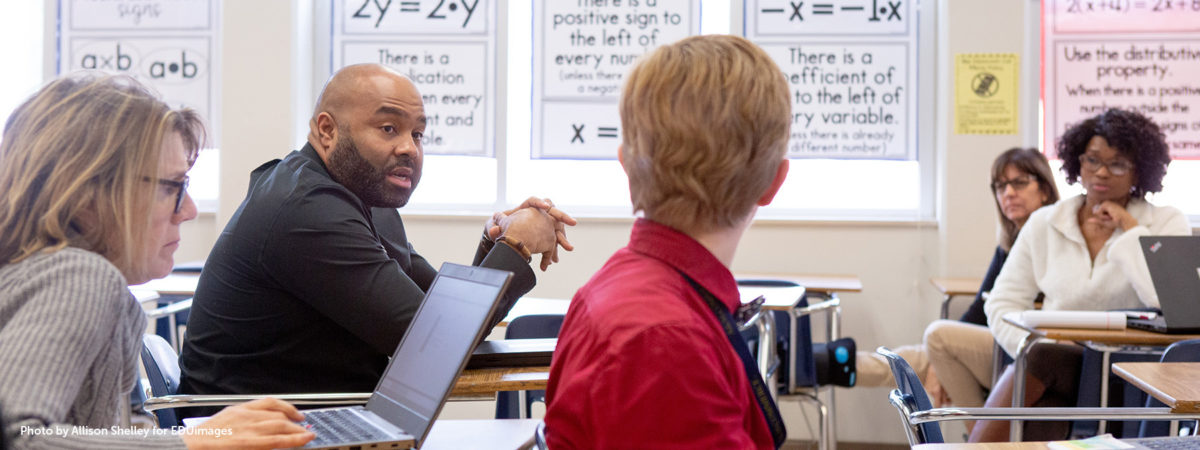
At the height of COVID-19, many schools weren’t able to undertake the full process of selecting and implementing a learning management system (LMS), even if they knew that this step would be foundational to achieving their vision for student learning.
As schools plan for the future, many administrators are now focusing on their district’s LMS strategy. Some districts seek to expand their LMS use, while others evaluating whether tools like Google Classroom or Seesaw are sufficient to meet their community’s needs.
In this blog post, I share a resource created for school leaders — a free guide to selecting an LMS for K-12 — and the rationale and process that went into creating it.
In educational futurist Michael B. Horn’s latest masterpiece, From Reopen to Reinvent: (Re)creating School for Every Child, he presents the difference between “threat framing” and “opportunity framing.”
There is a time and place for labeling threats as “threats” in K-12 education. Horn shares some fascinating research illuminating how “threat framing” is effective for marshaling resources and motivating action.
The COVID-19 pandemic offers an apt example of this mentality. The threats to both safety and learning led to a swift injection of federal aid dollars into the K-12 system across the nation.
But there is a downside here, which Horn refers to as “threat rigidity.” As Jamey Fitzpatrick, President and CEO of Michigan Virtual, explains, “It’s hard to remain curious when you feel threatened.”
We saw this tenuous balance firsthand in education during COVID-19. Schools across the country were forced to innovate almost overnight to provide emergency remote learning to their students.
As a result, this emergency remote learning was borne from necessity and tended to replicate face-to-face schedules without full consideration of research-based strategies for engaging students in virtual environments. One educator described this transition as moving from “teaching in 3D” to “teaching in 2D.”
As the immediate threat of the pandemic wanes, Horn’s poignant reframing suggests that we shift our focus back toward the opportunities available to students through flexible learning models and access to any time, any place, and any pace learning.
An LMS is a foundational component of most flexible learning models, offering a wide range of opportunities for students and teachers alike. A good LMS allows teachers to create and share content remotely, work collaboratively with students, create groups, and tailor their instruction to meet individual needs.
A research study my team conducted found that schools that did not already have an LMS in place struggled during emergency remote learning. In contrast, those who had already implemented more flexible instructional models, such as competency-based learning, fared much better with the transition.
Furthermore, a 2021 study we conducted found that a district-wide LMS ranks near the top of either current or planned future digital resources for Michigan schools and districts. The results of this study also suggest that school leaders expect to use more digital content moving forward but hope to have this content created directly by staff rather than purchasing content from a third-party provider.
Three weeks after Michigan’s K-12 schools closed, Michigan Virtual formed a workgroup of 25 classroom teachers, building administrators, and district-level leaders, each known for doing transformational work in their local communities.
During our meetings, we kept hearing that many school leaders wanted to initiate the process of implementing an LMS but didn’t know where to start. There were so many options and marketing pitches to sort through, making it challenging to sift through the noise to make a mission-driven decision.
Created by a team of educators intimately familiar with this process, our free Guide to Selecting an LMS for K-12 is split into three parts:
These three sections guide you to keep pedagogy at the core of your LMS decision-making process. The guide also includes a link to a webinar in which three Michigan districts showcase their LMSs and why they selected them.
As we look to the future of learning, it’s time to shift from threat to opportunity in K-12 education. To do this, we must explore flexible learning models and the powerful opportunities they can afford students when implemented appropriately.
An LMS is one foundational step in this journey, and should you embark down the path of acquiring one, we hope our free guide will be an asset in getting started. Explore our resource on design-thinking approaches to help you discern your community’s needs.

We want to hear from you!
Please take this 5-minute survey and help us serve you better.
